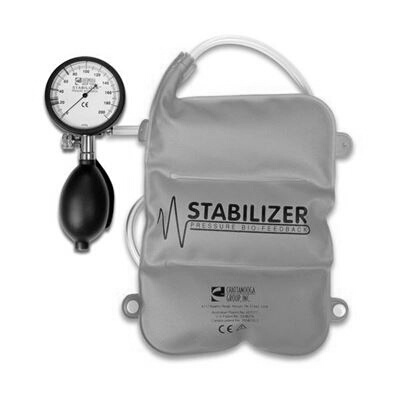The pressure biofeedback unit provides feedback to ensure quality in exercise performance and testing. It was developed by physiotherapy researchers Carolyn Richardson and Gwendolen Jull from The University of Queensland in the early 1990’s, to monitor the movement of irregularly-shaped body surfaces as an indirect assessment of the trunk and abdominal muscles’ collective ability to stabilise the lumbopelvic region.
Similar to a blood pressure sphygmomanometer, the unit was made with non-elastic, non-porous material, and included chambers to control the airflow, important for more accurate measurement. Designed in collaboration with an engineer from Chattanooga, Australia, the pressure biofeedback unit was patented in 1994 by UniQuest Pty Ltd, named the ‘Stabiliser’ and licenced to Chattanooga Group. Early publications explained its design features, provided results of calibration studies and demonstrated its clinical application in relation to monitoring control of the lumbopelvic region during exercise.
Later the pressure biofeedback was employed to aid the assessment and training of the deep cervical flexor muscles in persons with neck pain. The pressure biofeedback helped overcome a clinical challenge, i.e. the deep neck flexors cannot be seen or palpated accurately to assess their activation and low level functional endurance capacity. However the longus colli muscle flattens the cervical lordosis as it contracts. The pressure biofeedback proved very suitable to monitor this cervical curve movement, so as to provide feedback on the intensity and duration of the muscles’ contraction. The pressure biofeedback was a key element in the development and clinical utility of the craniocervical flexion test.
Description provided by Emeritus Professor Gwendolen Jull AO of Australia
References:
Richardson CA, et al. 1992. Techniques for active lumbar stabilisation for spinal protection: A pilot study. Australian Journal of Physiotherapy, 38, 105-12.
Jull GA, et al. 1993. Towards a measurement of active muscle control for lumbar stabilisation. Australian Journal of Physiotherapy, 39, 187-93.
Jull GA. 2000. Deep cervical flexor muscle dysfunction in whiplash. Journal of Musculoskeletal Pain, 8(1/2), 143-54.

